Paper Menu >>
Journal Menu >>
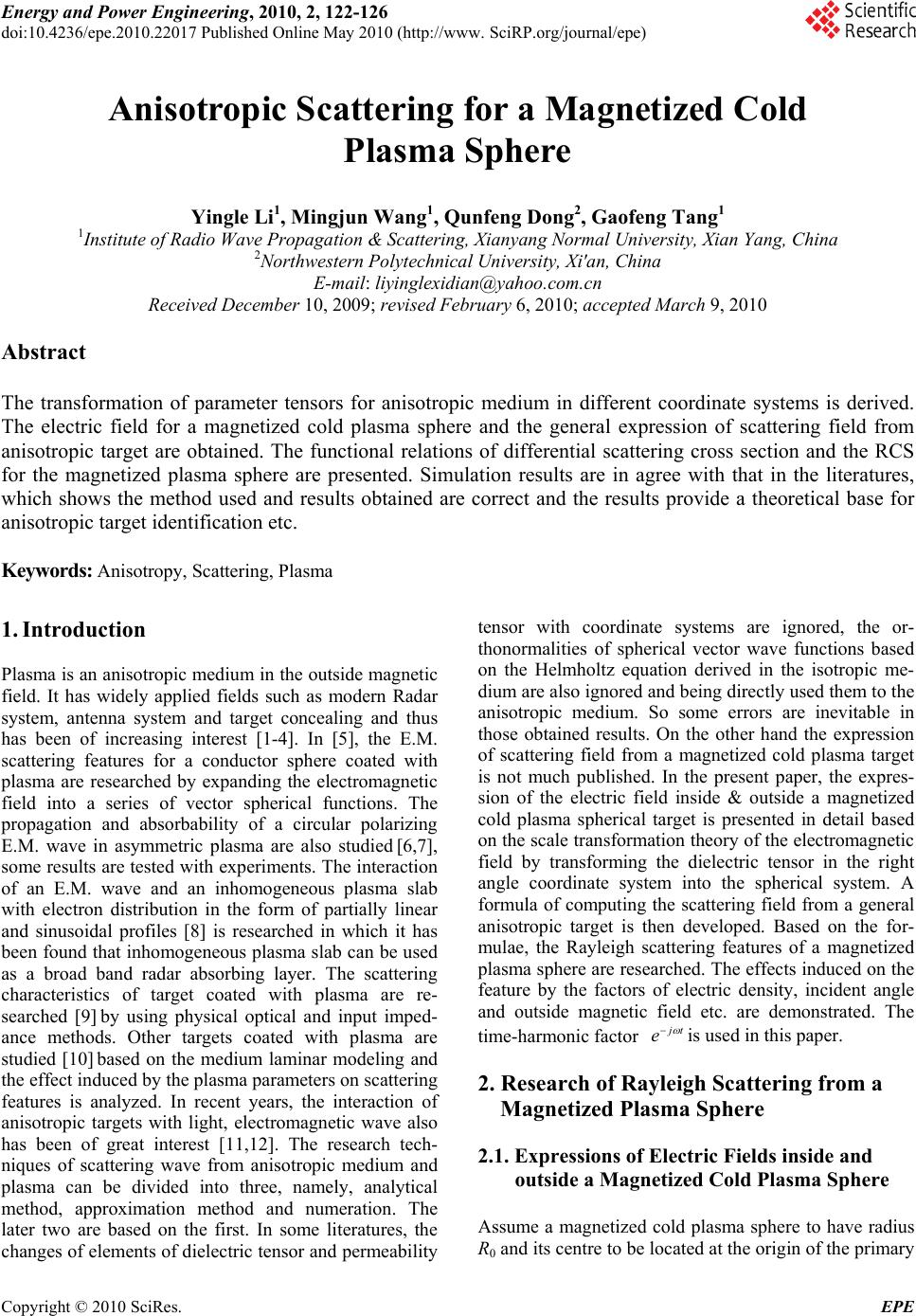 Energy and Power Engineering, 2010, 2, 122-126 doi:10.4236/epe.2010.22017 Published Online May 2010 (http://www. SciRP.org/journal/epe) Copyright © 2010 SciRes. EPE Anisotropic Scattering for a Magnetized Cold Plasma Sphere Yingle Li1, Mingjun Wang1, Qunfeng Dong2, Gaofeng Tang1 1Institute of Radio Wave Propagation & Scattering, Xianyang Normal University, Xian Yang, China 2Northwestern Polytechnical University, Xi'an, China E-mail: liyinglexidian@yahoo.com.cn Received December 10, 2009; revised February 6, 2010; accepted March 9, 2010 Abstract The transformation of parameter tensors for anisotropic medium in different coordinate systems is derived. The electric field for a magnetized cold plasma sphere and the general expression of scattering field from anisotropic target are obtained. The functional relations of differential scattering cross section and the RCS for the magnetized plasma sphere are presented. Simulation results are in agree with that in the literatures, which shows the method used and results obtained are correct and the results provide a theoretical base for anisotropic target identification etc. Keywords: Anisotropy, Scattering, Plasma 1. Introduction Plasma is an anisotropic medium in the outside magnetic field. It has widely applied fields such as modern Radar system, antenna system and target concealing and thus has been of increasing interest [1-4]. In [5], the E.M. scattering features for a conductor sphere coated with plasma are researched by expanding the electromagnetic field into a series of vector spherical functions. The propagation and absorbability of a circular polarizing E.M. wave in asymmetric plasma are also studied [6,7], some results are tested with experiments. The interaction of an E.M. wave and an inhomogeneous plasma slab with electron distribution in the form of partially linear and sinusoidal profiles [8] is researched in which it has been found that inhomogeneous plasma slab can be used as a broad band radar absorbing layer. The scattering characteristics of target coated with plasma are re- searched [9] by using physical optical and input imped- ance methods. Other targets coated with plasma are studied [10] based on the medium laminar modeling and the effect induced by the plasma parameters on scattering features is analyzed. In recent years, the interaction of anisotropic targets with light, electromagnetic wave also has been of great interest [11,12]. The research tech- niques of scattering wave from anisotropic medium and plasma can be divided into three, namely, analytical method, approximation method and numeration. The later two are based on the first. In some literatures, the changes of elements of dielectric tensor and permeability tensor with coordinate systems are ignored, the or- thonormalities of spherical vector wave functions based on the Helmholtz equation derived in the isotropic me- dium are also ignored and being directly used them to the anisotropic medium. So some errors are inevitable in those obtained results. On the other hand the expression of scattering field from a magnetized cold plasma target is not much published. In the present paper, the expres- sion of the electric field inside & outside a magnetized cold plasma spherical target is presented in detail based on the scale transformation theory of the electromagnetic field by transforming the dielectric tensor in the right angle coordinate system into the spherical system. A formula of computing the scattering field from a general anisotropic target is then developed. Based on the for- mulae, the Rayleigh scattering features of a magnetized plasma sphere are researched. The effects induced on the feature by the factors of electric density, incident angle and outside magnetic field etc. are demonstrated. The time-harmonic factor j t e is used in this paper. 2. Research of Rayleigh Scattering from a Magnetized Plasma Sphere 2.1. Expressions of Electric Fields inside and outside a Magnetized Cold Plasma Sphere Assume a magnetized cold plasma sphere to have radius R0 and its centre to be located at the origin of the primary 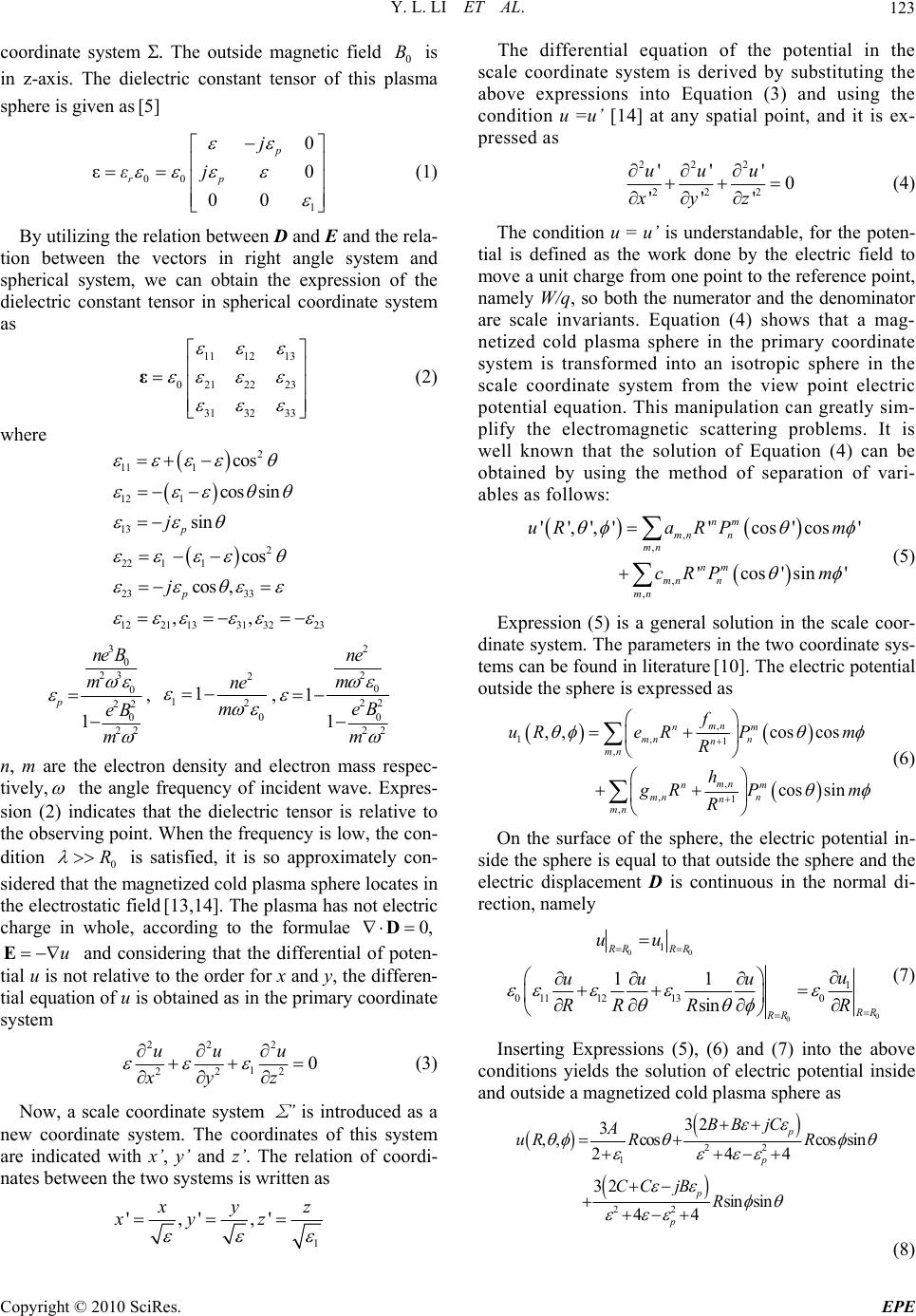 Y. L. LI ET AL.123 coordinate system Σ. The outside magnetic field is in z-axis. The dielectric constant tensor of this plasma sphere is given as [5] 0 B 00 1 0 ε0 00 p rp j εj (1) By utilizing the relation between D and E and the rela- tion between the vectors in right angle system and spherical system, we can obtain the expression of the dielectric constant tensor in spherical coordinate system as 11 1213 021 2223 31 3233 ε (2) where 2 11 1 12 1 13 2 22 11 23 33 1221 13313223 cos cos sin sin cos cos , ,, p p j j 3 0 23 0 22 0 22 1 p ne B m eB m , 2 12 0 1ne m , 2 2 0 22 0 22 1 1 ne m eB m n, m are the electron density and electron mass respec- tively, the angle frequency of incident wave. Expres- sion (2) indicates that the dielectric tensor is relative to the observing point. When the frequency is low, the con- dition 0 R is satisfied, it is so approximately con- sidered that the magnetized cold plasma sphere locates in the electrostatic field [13,14]. The plasma has not electric charge in whole, according to the formulae 0, D and considering that the differential of poten- tial u is not relative to the order for x and y, the differen- tial equation of u is obtained as in the primary coordinate system uE 22 2 1 22 2 0 uu u xy z (3) Now, a scale coordinate system Σ ’ is introduced as a new coordinate system. The coordinates of this system are indicated with x’, y’ and z’. The relation of coordi- nates between the two systems is written as 1 ',',' x yz xyz The differential equation of the potential in the scale coordinate system is derived by substituting the above expressions into Equation (3) and using the condition u =u’ [14] at any spatial point, and it is ex- pressed as 222 222 ''' 0 ''' uuu xyz (4) The condition u = u’ is understandable, for the poten- tial is defined as the work done by the electric field to move a unit charge from one point to the reference point, namely W/q, so both the numerator and the denominator are scale invariants. Equation (4) shows that a mag- netized cold plasma sphere in the primary coordinate system is transformed into an isotropic sphere in the scale coordinate system from the view point electric potential equation. This manipulation can greatly sim- plify the electromagnetic scattering problems. It is well known that the solution of Equation (4) can be obtained by using the method of separation of vari- ables as follows: , , , , '',','' cos'cos 'cos'sin' nm mn n mn nm mn n mn uRa RPm cRP m ' (5) Expression (5) is a general solution in the scale coor- dinate system. The parameters in the two coordinate sys- tems can be found in literature [10]. The electric potential outside the sphere is expressed as , 1, 1 , , ,1 , ,,cos cos cos sin mn nm mn n n mn mn nm mn n n mn f uRe RPm R h g RP Rm (6) On the surface of the sphere, the electric potential in- side the sphere is equal to that outside the sphere and the electric displacement D is continuous in the normal di- rection, namely 00 0 0 1 1 011 12130 11 sin RR RR R R RR uu u uu u RR RR (7) Inserting Expressions (5), (6) and (7) into the above conditions yields the solution of electric potential inside and outside a magnetized cold plasma sphere as 22 1 22 32 3 ,, coscossin 244 32 sin sin 44 p p p p BB jC A uR RR CCjBR (8) Copyright © 2010 SciRes. EPE 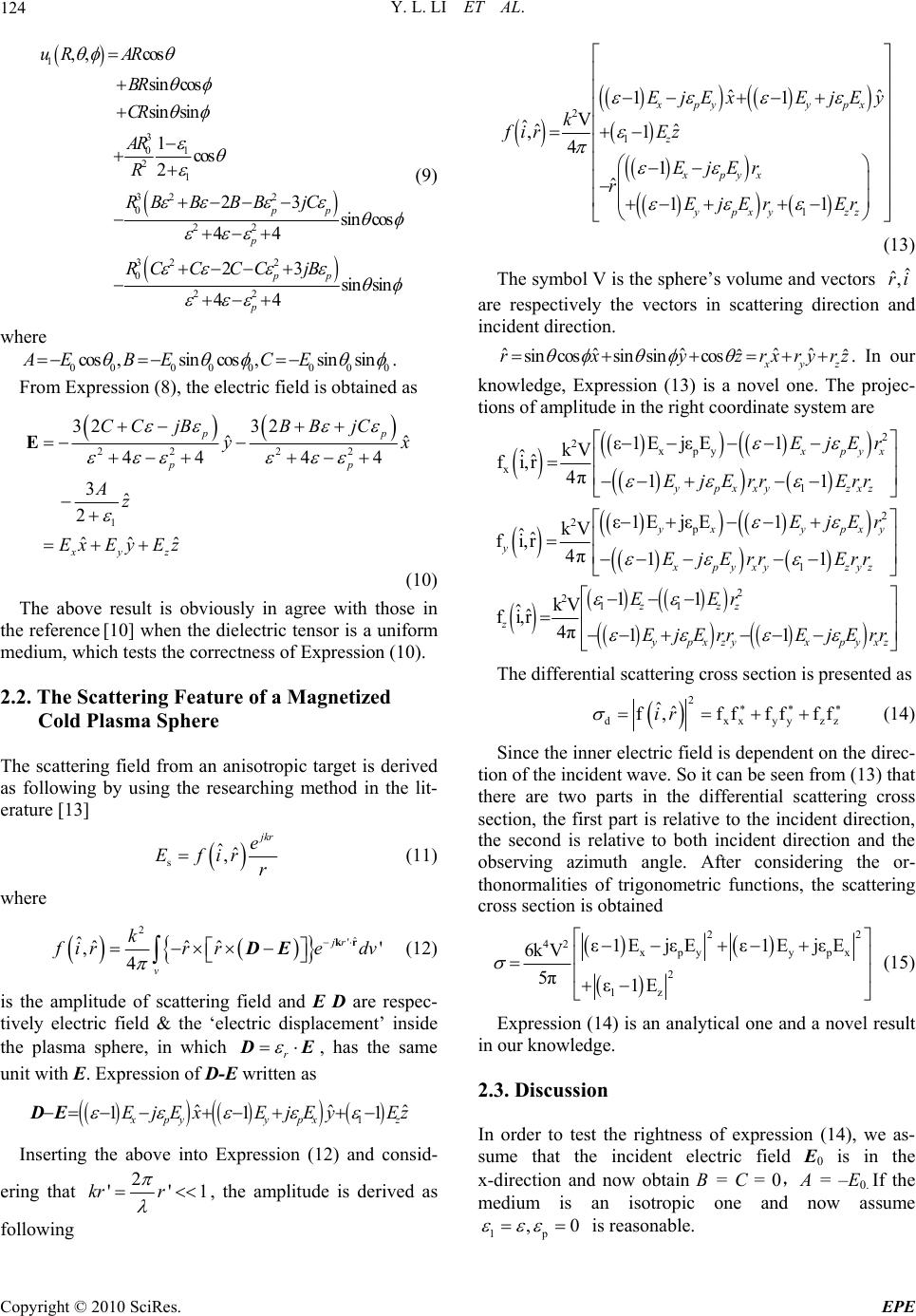 Y. L. LI ET AL. 124 1 3 01 2 1 32 2 0 22 32 2 0 22 ,, cos sin cos sin sin 1cos 2 23 sin cos 44 23 sin sin 44 pp p pp p uR AR BR CR AR R RB BBBjC RC CCCjB (9) where 00 000 00 cos ,sincos ,sinsinAE BECE0 . From Expression (8), the electric field is obtained as 22 22 1 32 32 ˆˆ 44 44 3ˆ 2 ˆˆˆ pp pp xyz CC jBBB jC y x Az Ex Ey Ez E (10) The above result is obviously in agree with those in the reference [10] when the dielectric tensor is a uniform medium, which tests the correctness of Expression (10). 2.2. The Scattering Feature of a Magnetized Cold Plasma Sphere The scattering field from an anisotropic target is derived as following by using the researching method in the lit- erature [13] sˆˆ , j kr e Efir r (11) where 2 ˆ ' ˆˆˆˆ ,' 4 jr v k f irr redv kr DE (12) is the amplitude of scattering field and E D are respec- tively electric field & the ‘electric displacement’ inside the plasma sphere, in which r D E, has the same unit with E. Expression of D-E written as 1 ˆˆ ˆ 111 x pyy pxz EjExEjEy Ez DE Inserting the above into Expression (12) and consid- ering that 2 ''kr r 2 1 1 ˆˆ 11 V ˆˆˆ ,1 4 1 ˆ 11 xpy ypx z xpyx ypxyzz EjExEjEy k fir Ez EjEr r EjEr Er (13) The symbol V is the sphere’s volume and vectors are respectively the vectors in scattering direction and incident direction. ˆ ˆ,ri ˆˆˆ ˆˆ ˆˆ sincossin sincos x yz rxyzrxryrz . In our knowledge, Expression (13) is a novel one. The projec- tions of amplitude in the right coordinate system are 2 2xpy x 1 ε1E jεE1 kV ˆˆ fi,r 4π11 x py x ypxxy zxz EjEr EjErrErr 2 2p 1 ε1E jεE1 kV ˆˆ fi,r 4π11 yx ypxy y xpyxyzyz EjEr EjErr Err 2 211 11 kV ˆˆ fi,r4π11 zzz z y px zyxpy xz EEr EjErr EjErr The differential scattering cross section is presented as 2 dxxyy ˆˆ f,ff ff ffir zz (14) Since the inner electric field is dependent on the direc- tion of the incident wave. So it can be seen from (13) that there are two parts in the differential scattering cross section, the first part is relative to the incident direction, the second is relative to both incident direction and the observing azimuth angle. After considering the or- thonormalities of trigonometric functions, the scattering cross section is obtained 22 42 xpy ypx 2 1z ε1E jεEε1EjεE 6k V 5πε1E (15) Expression (14) is an analytical one and a novel result in our knowledge. 2.3. Discussion In order to test the rightness of expression (14), we as- sume that the incident electric field E0 is in the x-direction and now obtain B = C = 0,A = –E0. If the medium is an isotropic one and now assume 1p , 1 , the amplitude is derived as following 0 is reasonable. Copyright © 2010 SciRes. EPE 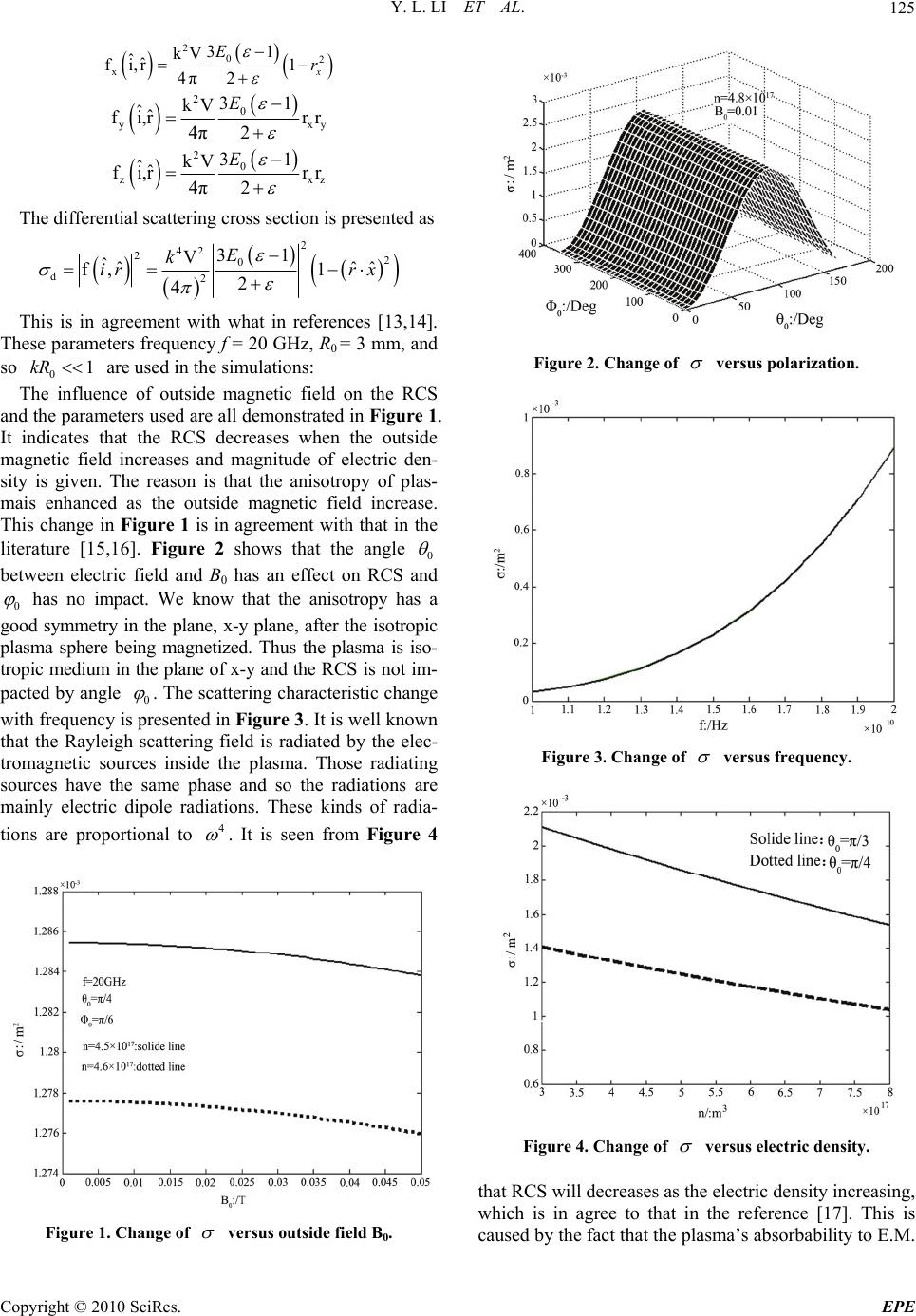 Y. L. LI ET AL.125 2 02 x 31 kV ˆˆ fi,r 1 4π2 x Er 2 0 yx 31 kV ˆˆ fi,r rr 4π2 E y 2 0 zx 31 kV ˆˆ fi,r rr 4π2 E z The differential scattering cross section is presented as 2 42 22 0 d2 31 V ˆˆˆˆ f, 1 2 4 E k ir rx This is in agreement with what in references [13,14]. These parameters frequency f = 20 GHz, R0 = 3 mm, and so are used in the simulations: 01kR The influence of outside magnetic field on the RCS and the parameters used are all demonstrated in Figure 1. It indicates that the RCS decreases when the outside magnetic field increases and magnitude of electric den- sity is given. The reason is that the anisotropy of plas- mais enhanced as the outside magnetic field increase. This change in Figure 1 is in agreement with that in the literature [15,16]. Figure 2 shows that the angle 0 between electric field and B0 has an effect on RCS and 0 has no impact. We know that the anisotropy has a good symmetry in the plane, x-y plane, after the isotropic plasma sphere being magnetized. Thus the plasma is iso- tropic medium in the plane of x-y and the RCS is not im- pacted by angle 0 . The scattering characteristic change with frequency is presented in Figure 3. It is well known that the Rayleigh scattering field is radiated by the elec- tromagnetic sources inside the plasma. Those radiating sources have the same phase and so the radiations are mainly electric dipole radiations. These kinds of radia- tions are proportional to 4 . It is seen from Figure 4 Figure 1. Change of versus outside field B0. Figure 2. Change of versus polarization. Figure 3. Change of versus frequency. Figure 4. Change of versus electric density. that RCS will decreases as the electric density increasing, which is in agree to that in the reference [17]. This is caused by the fact that the plasma’s absorbability to E.M. Copyright © 2010 SciRes. EPE 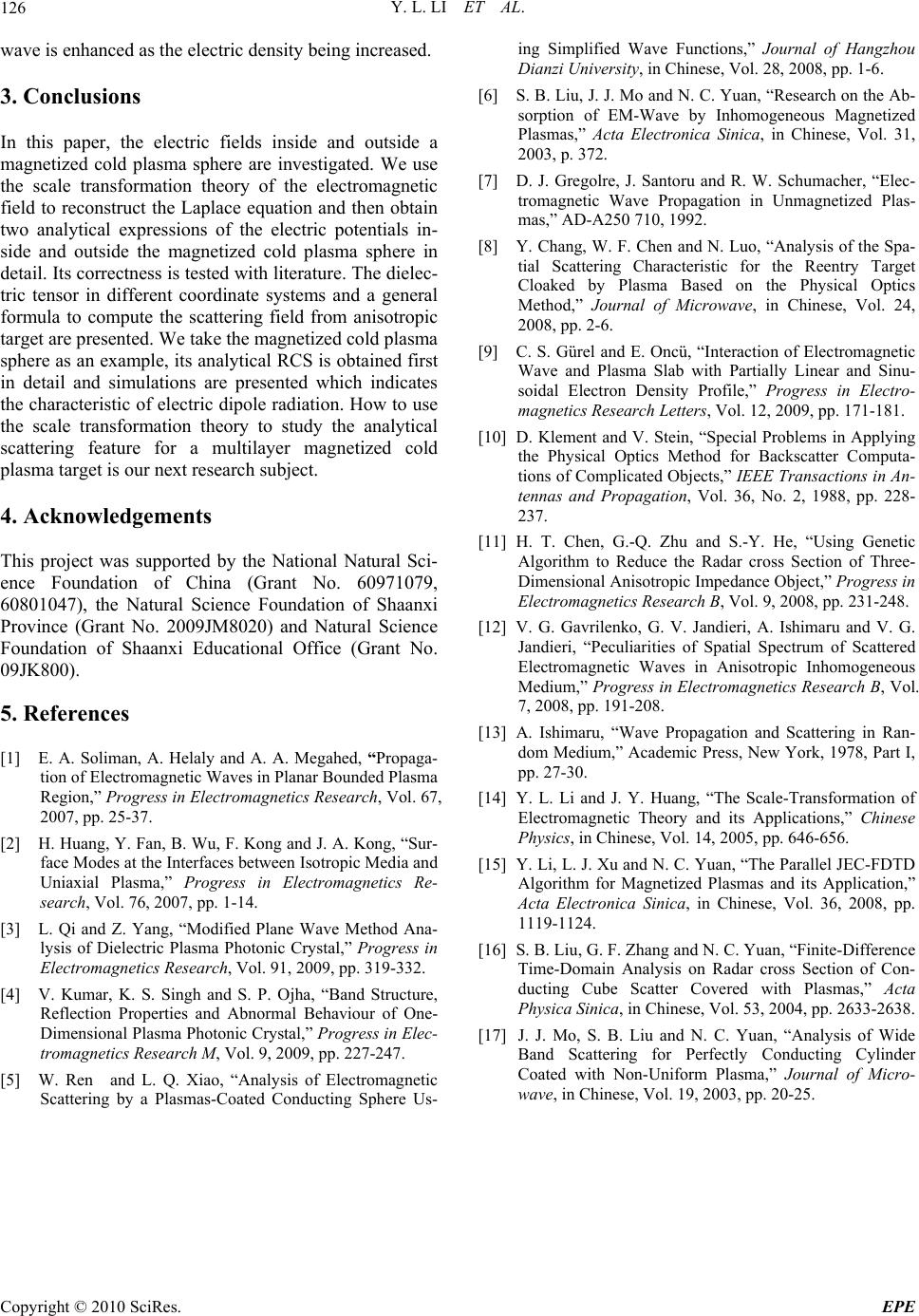 Y. L. LI ET AL. Copyright © 2010 SciRes. EPE 126 wave is enhanced as the electric density being increased. 3. Conclusions In this paper, the electric fields inside and outside a magnetized cold plasma sphere are investigated. We use the scale transformation theory of the electromagnetic field to reconstruct the Laplace equation and then obtain two analytical expressions of the electric potentials in- side and outside the magnetized cold plasma sphere in detail. Its correctness is tested with literature. The dielec- tric tensor in different coordinate systems and a general formula to compute the scattering field from anisotropic target are presented. We take the magnetized cold plasma sphere as an example, its analytical RCS is obtained first in detail and simulations are presented which indicates the characteristic of electric dipole radiation. How to use the scale transformation theory to study the analytical scattering feature for a multilayer magnetized cold plasma target is our next research subject. 4. Acknowledgements This project was supported by the National Natural Sci- ence Foundation of China (Grant No. 60971079, 60801047), the Natural Science Foundation of Shaanxi Province (Grant No. 2009JM8020) and Natural Science Foundation of Shaanxi Educational Office (Grant No. 09JK800). 5 . References [1] E. A. Soliman, A. Helaly and A. A. Megahed, “Propaga- tion of Electromagnetic Waves in Planar Bounded Plasma Region,” Progress in Electromagnetics Research, Vol. 67, 2007, pp. 25-37. [2] H. Huang, Y. Fan, B. Wu, F. Kong and J. A. Kong, “Sur- face Modes at the Interfaces between Isotropic Media and Uniaxial Plasma,” Progress in Electromagnetics Re- search, Vol. 76, 2007, pp. 1-14. [3] L. Qi and Z. Yang, “Modified Plane Wave Method Ana- lysis of Dielectric Plasma Photonic Crystal,” Progress in Electromagnetics Research, Vol. 91, 2009, pp. 319-332. [4] V. Kumar, K. S. Singh and S. P. Ojha, “Band Structure, Reflection Properties and Abnormal Behaviour of One- Dimensional Plasma Photonic Crystal,” Progress in Elec- tromagnetics Research M, Vol. 9, 2009, pp. 227-247. [5] W. Ren and L. Q. Xiao, “Analysis of Electromagnetic Scattering by a Plasmas-Coated Conducting Sphere Us- ing Simplified Wave Functions,” Journal of Hangzhou Dianzi University, in Chinese, Vol. 28, 2008, pp. 1-6. [6] S. B. Liu, J. J. Mo and N. C. Yuan, “Research on the Ab- sorption of EM-Wave by Inhomogeneous Magnetized Plasmas,” Acta Electronica Sinica, in Chinese, Vol. 31, 2003, p. 372. [7] D. J. Gregolre, J. Santoru and R. W. Schumacher, “Elec- tromagnetic Wave Propagation in Unmagnetized Plas- mas,” AD-A250 710, 1992. [8] Y. Chang, W. F. Chen and N. Luo, “Analysis of the Spa- tial Scattering Characteristic for the Reentry Target Cloaked by Plasma Based on the Physical Optics Method,” Journal of Microwave, in Chinese, Vol. 24, 2008, pp. 2-6. [9] C. S. Gürel and E. Oncü, “Interaction of Electromagnetic Wave and Plasma Slab with Partially Linear and Sinu- soidal Electron Density Profile,” Progress in Electro- magnetics Research Letters, Vol. 12, 2009, pp. 171-181. [10] D. Klement and V. Stein, “Special Problems in Applying the Physical Optics Method for Backscatter Computa- tions of Complicated Objects,” IEEE Transactions in An- tennas and Propagation, Vol. 36, No. 2, 1988, pp. 228- 237. [11] H. T. Chen, G.-Q. Zhu and S.-Y. He, “Using Genetic Algorithm to Reduce the Radar cross Section of Three- Dimensional Anisotropic Impedance Object,” Progress in Electromagnetics Research B, Vol. 9, 2008, pp. 231-248. [12] V. G. Gavrilenko, G. V. Jandieri, A. Ishimaru and V. G. Jandieri, “Peculiarities of Spatial Spectrum of Scattered Electromagnetic Waves in Anisotropic Inhomogeneous Medium,” Progress in Electromagnetics Research B, Vol. 7, 2008, pp. 191-208. [13] A. Ishimaru, “Wave Propagation and Scattering in Ran- dom Medium,” Academic Press, New York, 1978, Part I, pp. 27-30. [14] Y. L. Li and J. Y. Huang, “The Scale-Transformation of Electromagnetic Theory and its Applications,” Chinese Physics, in Chinese, Vol. 14, 2005, pp. 646-656. [15] Y. Li, L. J. Xu and N. C. Yuan, “The Parallel JEC-FDTD Algorithm for Magnetized Plasmas and its Application,” Acta Electronica Sinica, in Chinese, Vol. 36, 2008, pp. 1119-1124. [16] S. B. Liu, G. F. Zhang and N. C. Yuan, “Finite-Difference Time-Domain Analysis on Radar cross Section of Con- ducting Cube Scatter Covered with Plasmas,” Acta Physica Sinica, in Chinese, Vol. 53, 2004, pp. 2633-2638. [17] J. J. Mo, S. B. Liu and N. C. Yuan, “Analysis of Wide Band Scattering for Perfectly Conducting Cylinder Coated with Non-Uniform Plasma,” Journal of Micro- wave, in Chinese, Vol. 19, 2003, pp. 20-25. |

